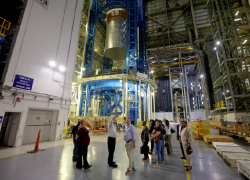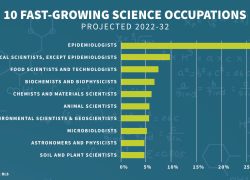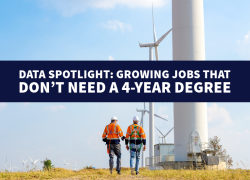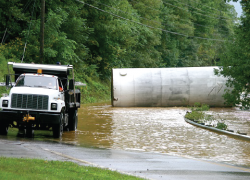 Space exploration impacts industries across the globe, including healthcare, agriculture, telecommunications and climate management. Astronauts may be the best-known space workers, but they hold few of the jobs. The logistics of space missions require a large team of workers with a variety of skills and training backgrounds.
Space exploration impacts industries across the globe, including healthcare, agriculture, telecommunications and climate management. Astronauts may be the best-known space workers, but they hold few of the jobs. The logistics of space missions require a large team of workers with a variety of skills and training backgrounds.
If you’re interested in space, you could channel that curiosity into a growing career in a variety of related fields. Below we’re highlighting 10 occupations you’ll find within the space sector – and beyond. These occupations all offer above-average projected growth and good pay.
Aerospace engineers design, develop, and test aircraft, spacecraft, satellites, and missiles.
Employment growth, projected 2022-32: 6% (faster than average)
Median annual wage, 2023: $130,720
Typical entry-level education: Bachelor’s degree
Number of jobs, 2022: 63,800
Occupational openings, projected 2022–32 annual average: 3,800
Astronomers and physicists research and interpret the interactions of matter and energy.
Employment growth, projected 2022–32: 5% (faster than average)
Median annual wage, 2023: $149,530
Typical entry-level education: Doctoral or professional degree
Number of jobs, 2022: 23,600
Occupational openings, projected 2022–32 annual average: 1,500
Environmental scientists and specialists use their knowledge of the natural sciences to protect the environment and human health.
Employment growth, projected 2022–32: 6% (faster than average)
Median annual wage, 2023: $78,980
Typical entry-level education: Bachelor’s degree
Number of jobs, 2022: 80,500
Occupational openings, projected 2022–32 annual average: 6,900
Information security analysts plan and carry out security measures to protect an organization’s computer networks and systems.
Employment growth, projected 2022-32: 32% (much faster than average)
Median annual wage, 2023: $120,360
Typical entry-level education: Bachelor’s degree
Number of jobs, 2022: 168,900
Occupational openings, projected 2022–32 annual average: 16,800
Logisticians analyze and coordinate an organization’s supply chain. For large-scale projects with a lot of moving pieces – like space travel – this is a critical role.
Employment growth, projected 2022-32: 18% (much faster than average)
Median annual wage, 2023: $79,400
Typical entry-level education: Bachelor’s degree
Number of jobs, 2022: 208,700
Occupational openings, projected 2022–32 annual average: 21,800
Statisticians, along with mathematicians, analyze data and apply computational techniques to solve problems, like the team in Hidden Figures.
Employment growth, projected 2022-32: 32% (much faster than average)
Median annual wage, 2023: $104,110
Typical entry-level education: Master's degree
Number of jobs, 2022: 33, 300
Occupational openings, projected 2022–32 annual average: 3, 300
Soil and plant scientists examine the composition of soil, how it affects plant or crop growth, and how alternative soil treatments affect crop productivity. (And despite what you may have seen in the movies, no plant scientist has ever been stranded on Mars.)
Employment growth, projected 2022–32: 5% (faster than average)
Median annual wage, 2023: $68,240
Typical entry-level education: Bachelor’s degree
Number of jobs, 2022: 17,200
Occupational openings, projected 2022–32 annual average: 1,400
Not all of these careers require a bachelor’s or graduate degree. Here are three space-related occupations you can enter with less than a 4-year degree.
Aerospace engineering and operations technologists and technicians help aerospace engineers design, develop and test products. For example, they might help to conduct a rocket test and compare the results with objectives.
Employment growth, projected 2022–32: 8% (faster than average)
Median annual wage, 2023: $77,830
Typical entry-level education: Associate’s degree
Number of jobs, 2022: 10,200
Occupational openings, projected 2022–32 annual average: 1,000
Heating, air conditioning, and refrigeration mechanics and installers work on the systems that control temperature and air quality in an aircraft.
Employment growth, projected 2022–32: 6% (faster than average)
Median annual wage, 2023: $57,300
Typical entry-level education: Postsecondary nondegree award
Number of jobs, 2022: 415,800
Occupational openings, projected 2022–32 annual average: 37,700
Industrial machinery mechanics detect and repair equipment before the machines are damaged.
Employment growth, projected 2022–32: 15% (much faster than average)
Median annual wage, 2023: $61,420
Typical entry-level education: High school diploma or equivalent
Number of jobs, 2022: 402,200
Occupational openings, projected 2022–32 annual average: 39,200
Check out these and hundreds of other occupations in the Bureau of Labor Statistics’ Occupational Outlook Handbook, or by downloading the CareerInfo app.
The space sector will be responsible for powering the next generation of space exploration, research, and innovation. Good jobs right here on earth are required to make that happen, from advanced manufacturing to quality control to maintenance and beyond. The department is excited to be joining the National Space Council and others for Find Your Place in Space Week, April 6-13.
- Learn more about finding your place in space
- Read more about interagency work to support space-related STEM education and workforce
- Learn more about open funding opportunities to build and expand Registered Apprenticeship programs
Follow BLS on X at @BLS_gov.

 U.S. Department of Labor Blog
U.S. Department of Labor Blog







